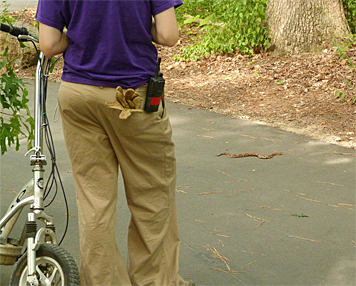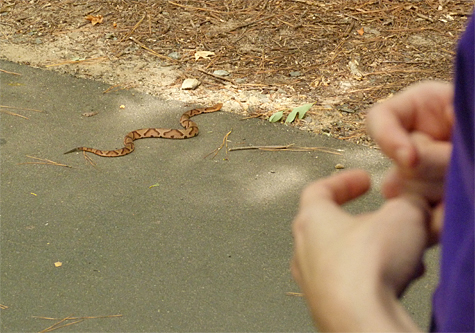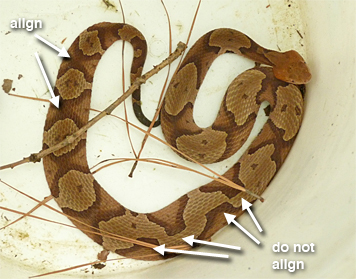Not more than twenty minutes after seeing the first copperhead in Explore the Wild (8/26/11), another call came in from Rachael (Entomology Specialist) that a snake was on the path near the head of the Dinosaur Trail. Rushing off to that location, we discovered a larger Copperhead more accustomed to the presence of humans, it was leisurely crawling across the pavement and headed for the woods.

Leave it alone and it will leave you alone.

Unfortunately the snake crawled under a rock in an area frequented by people and had to be relocated. In doing so it was placed in a five gallon bucket for transport which, while in the bucket, afforded excellent looks at the pattern on its back.
If you look at the photo below you will see that the pattern breaks up about midway down the snake’s back. That broken pattern is a characteristic of Southern Cooperhead (Agkistrodon contortrix contortrix).

The snake seen earlier, the smaller Copperhead in Explore the Wild, had a complete uninterrupted pattern. Does that mean that it was not a Southern Copperhead? Northern Copperheads (Agkistrodon contortrix mokasen) do occur in our area, according to Conant/Collins, “Reptiles and Amphibians: Eastern/Central North America,” and do not exhibit the misaligned hourglass pattern. Reading further, the book states that the broken pattern occurs “very often” in Southern Copperheads, not necessarily in every snake encountered. So, I’m not sure of the younger snake’s parentage. But, Northerns tend to be darker than Southerns, so I’m going with Southern.
Why all this discussion about Copperheads? Well, about two or more weeks back the seasons took a turn towards fall. From here on we’ll be seeing creatures preparing for what’s to come. For snakes, that’s moving around actively seeking food, and then heading off to find a nice safe place to spend the winter whether that’s an individual burrow or a communal den. So, they’ll be moving around a lot more than they would during summer.
The Durham area, even residential Durham, is populated with snakes, including Copperheads. You may run into one of these snakes while hiking your favorite trail in Duke Forest, the Eno River, or even here at the Museum. Just let the snake be and it will let you be.
It’s sometimes difficult to see Copperheads, to differentiate them from the ground, on the trails at Duke Forest or the Eno, but it’d be hard to miss one on the pavement here at the Museum. You’re not likely to accidentally step on one here, which is how most folks are bitten. See it, walk around it, or just stand well away from it, and it will crawl off into the woods, I promise.
Enjoy the snakes for what they are, a well established, interesting, and important part of the world we live in.
Happy Trails!